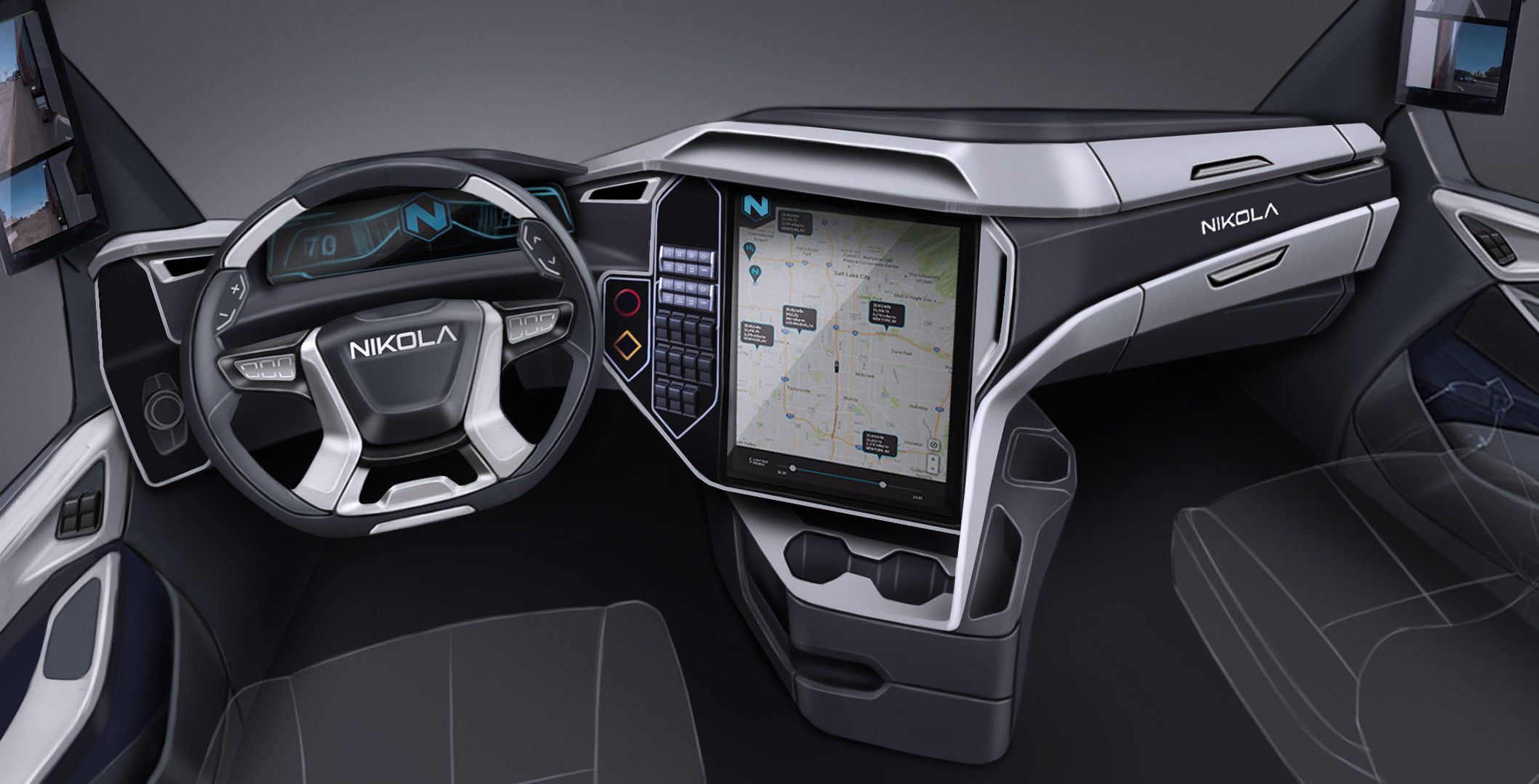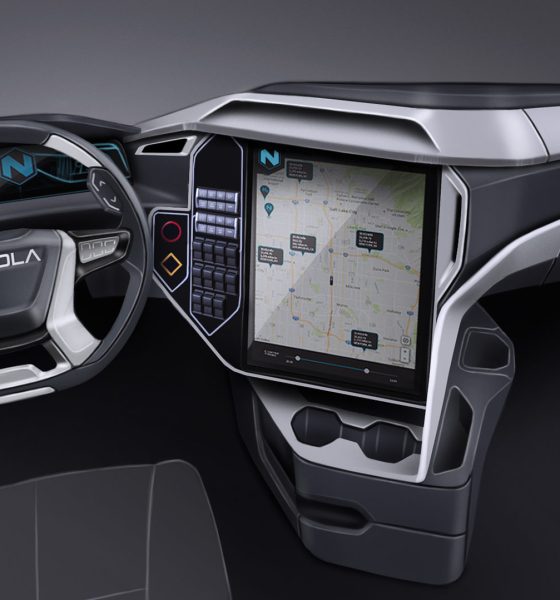

News
Tesla Semi competitor Nikola Motor promotes custom OS, 3-yr production estimate
As it continues the development of its first hydrogen-electric truck, Tesla Semi rival Nikola Motor posted an update on the software development for its vehicles. In a post on Twitter, Nikola noted that its custom operating system has reached a point where it could be cold booted in seconds. The hydrogen-electric truck startup also provided what appears to be a brief update on its software’s rollout. In its post, Nikola mentioned that its software still has three years of optimization left before it enters production.
How awesome is Nikola's operating system and instrument cluster? We can cold boot the infotainment system and instrument cluster in less than 8 seconds from start! And we have 3 years optimization left before production!
— Nikola Corporation (@nikolamotor) February 3, 2019
While Nikola is yet to release details about the upcoming custom OS for its hydrogen-electric trucks, the company has teased a number of features centered around its software nonetheless. Among these is the Digital Cockpit, which allows drivers to control most of the trucks’ functions and through a center 21″ touchscreen, as well as a feature called Surround Vision, which gives operators a virtual aerial view of the area surrounding the truck in real time. This feature is made possible by using a suite of cameras, radar, sonar, and computing software, allowing truck drivers to fully cover their blind spots while driving. Nikola also notes that its vehicles are equipped with the necessary hardware to enable full autonomous safety and convenience features.
That said, Nikola does have quite a lot of work to do before it could market its hydrogen-electric trucks as a viable alternative to diesel and all-electric long-haulers like the Tesla Semi, which is expected to begin initial production sometime this year. Nevertheless, the hydrogen-electric truck startup has ambitious plans for its vehicles’ hydrogen refueling network, with the company aiming to set up an estimated 820 refilling stations operating across the United States by 2028.
The emergence of zero-emissions vehicles like the Nikola One and the Tesla Semi could herald the start of a new era for the trucking market. Considering their capabilities, vehicles like Nikola One could replace long-range diesel trucks, and all-electric units like the Tesla Semi could easily dominate the market for shorter-range routes. This particular point appears to be evident for Nikola Motor CEO Trevor Milton, who recently took to LinkedIn to invite former Tesla employees who were affected by the electric car maker’s recent round of layoffs, which affected 7% of the company’s workforce.
In his post, Milton noted that his invitation to former Tesla employees is not in any way throwing shade at the electric car maker. The Nikola CEO also stated that the hydrogen-electric truck maker has “large cash reserves” to support hundreds of new employees. Following is Milton’s LinkedIn invitation.
“Forward this on to all Tesla workers. Anyone who was affected by the #tesla layoffs, please let me know and I’ll try to get you in front of our HR to be reviewed. We have hired as many as fit our positions from the #faraday and #gm layoffs so this is not a bash on Tesla. We are hiring hundreds of positions and have large cash reserves with a great company culture. See our glass door. I am taking time out of my crazy schedule to try to help in these situations.
“I feel for everyone that goes through that especially with financial obligations. If #tesla could they would keep everyone but it’s the result in growing in a competitive market. I hope I can help all those affected. Please DM me directly WITH your resume attached. I don’t have time to email asking for it so please include it and I’ll try to help as much as I can. You can also email joe.pike@nikolamotor.com if you want direct contact to HR.”
Nikola is currently preparing for Nikola World 2019, a two-day event in April that would feature the unveiling of the pre-production models of its hydrogen-electric trucks. The hydrogen-electric truck startup is also planning to unveil a 2.3-megawatt H2 fueling station that serves as a model for Nikola’s upcoming network of refilling stations at the upcoming event.

News
Tesla FSD fleet is nearing 7 billion total miles, including 2.5 billion city miles
As can be seen on Tesla’s official FSD webpage, vehicles equipped with the system have now navigated over 6.99 billion miles.

Tesla’s Full Self-Driving (Supervised) fleet is closing in on almost 7 billion total miles driven, as per data posted by the company on its official FSD webpage.
These figures hint at the massive scale of data fueling Tesla’s rapid FSD improvements, which have been quite notable as of late.
FSD mileage milestones
As can be seen on Tesla’s official FSD webpage, vehicles equipped with the system have now navigated over 6.99 billion miles. Tesla owner and avid FSD tester Whole Mars Catalog also shared a screenshot indicating that from the nearly 7 billion miles traveled by the FSD fleet, more than 2.5 billion miles were driven inside cities.
City miles are particularly valuable for complex urban scenarios like unprotected turns, pedestrian interactions, and traffic lights. This is also the difference-maker for FSD, as only complex solutions, such as Waymo’s self-driving taxis, operate similarly on inner-city streets. And even then, incidents such as the San Francisco blackouts have proven challenging for sensor-rich vehicles like Waymos.
Tesla’s data edge
Tesla has a number of advantages in the autonomous vehicle sector, one of which is the size of its fleet and the number of vehicles training FSD on real-world roads. Tesla’s nearly 7 billion FSD miles then allow the company to roll out updates that make its vehicles behave like they are being driven by experienced drivers, even if they are operating on their own.
So notable are Tesla’s improvements to FSD that NVIDIA Director of Robotics Jim Fan, after experiencing FSD v14, noted that the system is the first AI that passes what he described as a “Physical Turing Test.”
“Despite knowing exactly how robot learning works, I still find it magical watching the steering wheel turn by itself. First it feels surreal, next it becomes routine. Then, like the smartphone, taking it away actively hurts. This is how humanity gets rewired and glued to god-like technologies,” Fan wrote in a post on X.
News
Tesla starts showing how FSD will change lives in Europe
Local officials tested the system on narrow country roads and were impressed by FSD’s smooth, human-like driving, with some calling the service a game-changer for everyday life in areas that are far from urban centers.

Tesla has launched Europe’s first public shuttle service using Full Self-Driving (Supervised) in the rural Eifelkreis Bitburg-Prüm region of Germany, demonstrating how the technology can restore independence and mobility for people who struggle with limited transport options.
Local officials tested the system on narrow country roads and were impressed by FSD’s smooth, human-like driving, with some calling the service a game-changer for everyday life in areas that are far from urban centers.
Officials see real impact on rural residents
Arzfeld Mayor Johannes Kuhl and District Administrator Andreas Kruppert personally tested the Tesla shuttle service. This allowed them to see just how well FSD navigated winding lanes and rural roads confidently. Kruppert said, “Autonomous driving sounds like science fiction to many, but we simply see here that it works totally well in rural regions too.” Kuhl, for his part, also noted that FSD “feels like a very experienced driver.”
The pilot complements the area’s “Citizen Bus” program, which provides on-demand rides for elderly residents who can no longer drive themselves. Tesla Europe shared a video of a demonstration of the service, highlighting how FSD gives people their freedom back, even in places where public transport is not as prevalent.
What the Ministry for Economic Affairs and Transport says
Rhineland-Palatinate’s Minister Daniela Schmitt supported the project, praising the collaboration that made this “first of its kind in Europe” possible. As per the ministry, the rural rollout for the service shows FSD’s potential beyond major cities, and it delivers tangible benefits like grocery runs, doctor visits, and social connections for isolated residents.
“Reliable and flexible mobility is especially vital in rural areas. With the launch of a shuttle service using self-driving vehicles (FSD supervised) by Tesla in the Eifelkreis Bitburg-Prüm, an innovative pilot project is now getting underway that complements local community bus services. It is the first project of its kind in Europe.
“The result is a real gain for rural mobility: greater accessibility, more flexibility and tangible benefits for everyday life. A strong signal for innovation, cooperation and future-oriented mobility beyond urban centers,” the ministry wrote in a LinkedIn post.
News
Tesla China quietly posts Robotaxi-related job listing
Tesla China is currently seeking a Low Voltage Electrical Engineer to work on circuit board design for the company’s autonomous vehicles.

Tesla has posted a new job listing in Shanghai explicitly tied to its Robotaxi program, fueling speculation that the company is preparing to launch its dedicated autonomous ride-hailing service in China.
As noted in the listing, Tesla China is currently seeking a Low Voltage Electrical Engineer to work on circuit board design for the company’s autonomous vehicles.
Robotaxi-specific role
The listing, which was shared on social media platform X by industry watcher @tslaming, suggested that Tesla China is looking to fill the role urgently. The job listing itself specifically mentions that the person hired for the role will be working on the Low Voltage Hardware team, which would design the circuit boards that would serve as the nervous system of the Robotaxi.
Key tasks for the role, as indicated in the job listing, include collaboration with PCB layout, firmware, mechanical, program management, and validation teams, among other responsibilities. The role is based in Shanghai.
China Robotaxi launch
China represents a massive potential market for robotaxis, with its dense urban centers and supportive policies in select cities. Tesla has limited permission to roll out FSD in the country, though despite this, its vehicles have been hailed as among the best in the market when it comes to autonomous features. So far, at least, it appears that China supports Tesla’s FSD and Robotaxi rollout.
This was hinted at in November, when Tesla brought the Cybercab to the 8th China International Import Expo (CIIE) in Shanghai, marking the first time that the autonomous two-seater was brought to the Asia-Pacific region. The vehicle, despite not having a release date in China, received a significant amount of interest among the event’s attendees.








